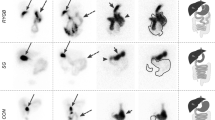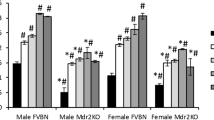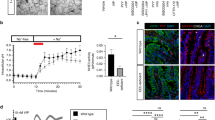Abstract
ABSTRACT: To gain information about the ontogeny of neonatal biliary physiology, we determined gallbladder bile composition, hepatic bile flow and composition, and the choleretic effects of taurocholate, taurodehydrocholate, secretin, and glucagon in anesthetized puppies of 0-3 (n=13), 7-21 (n=9), and 28-42 (n=8) days of age, and in fed (n=4) and fasted (n=4) adult dogs. Although gallbladder bile volume was similar in all puppies, chloride concentration in gallbladder bile declined with age (54.2, 33.2, 22.6, 15.9, and 5.8 mEq/liter in these respective groups), and so did bicarbonate concentration (43.5, 26.1, 17.6, 11.4, and 5.7 mEq/liter). In contrast, the concentrations of sodium (175.4, 189.2, 224.5, 251.6, and 279.4 mEq/liter) and bile acids (77.8, 137.3, 206.2, 219.6, and 280.7 mEq/liter) increased. Spontaneous bile flow rate in 0- to 3-day-old puppies averaged 0.194 µl/min/g and increased to 0.365 µl/min/g in puppies of 28-42 days of age. The latter value was not significantly different from that in fed adult dogs (0.344 µl/min/g). 14C-erythritol bile-to-plasma ratio in spontaneously secreted bile increased with age (1.05, 1.08,1.26, 1.48, and 1.70), and chloride concentration decreased (96.8, 85.8, 79.2, 74.3, and 60.1 mEq/ liter). The choleretic activity of taurocholate (2 µmol/min/ kg) was the same in all puppies (7.8 µl/jumol) and adult animals (7.2 µl/fimoY). Taurodehydrocholate (2 µmol/min/ kg) increased bile flow by a greater magnitude, yet its choleretic activity in the puppies (13.3 µl/jtmol) was the same as that in adult dogs (12.7 µl/µmol). In all animals, total bile acid excretion accounted for 70-95% of the infused taurocholate or taurodehydrocholate. Secretin (1- 20 CU/kg/h) and glucagon (1-20 µg/kg/h) produced a minimal, or no effect on bile flow in 0- to 3-day-old puppies. In puppies of 28-42 days of age, the choleretic effect of these hormones was 30-45% of that seen in adult animals. These findings suggest that gallbladder and ductular bile water reabsorption, canalicular secretion, and hormone choleresis are all deficient processes in the newborn puppy and develop during postnatal life.
Similar content being viewed by others
Article PDF
Author information
Authors and Affiliations
Rights and permissions
About this article
Cite this article
Tavoloni, N. Bile Secretion and its Control in the Newborn Puppy. Pediatr Res 20, 203–208 (1986). https://doi.org/10.1203/00006450-198603000-00001
Received:
Accepted:
Issue Date:
DOI: https://doi.org/10.1203/00006450-198603000-00001



